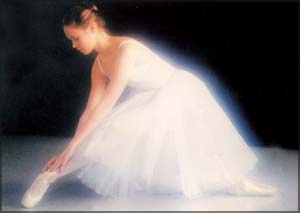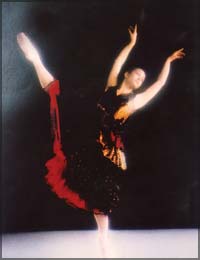The endearing quality of ballet costumes
Gwen HERAT
|

From pristine white in Swan Lake.
|
British ballet has been known to control the quality of ballet
costumes retaining its brilliance, pristine beauty and authenticity
after venturing into add colour to the otherwise pure white that has
been associated with the costume worn by the ballerina. Ballet felt that
the audience needed a change and added colour and glitzy work to enhance
her appearance.
It proved right to capture the imagination of some people but not
all, they being the ones who stood by white associated with classical
ballet and among them I being one. Time change; so does the arts scene
that includes ballet with the future beckoning changes to suit the
appetite of all. Look at the pop scene as compared to about a couple of
decades when we use to hear beautiful songs set to enchanting musical
scores. It is different today.
All I hear is a clash of noises arising from irrelevant musical
instruments, sung in shrieks and from noises like the braying of
donkeys, neighing of horses or one being throttled. I think it started
with Michael Jackson and the mania continued but we do get a few pop
singers like Elton John, Eric Clapton, Lionel Richie, Nana Mousekuri
etc. who are acceptable.
Costumes have developed technically over the centuries from formal to
modern and thank God, they are not eccentric.
As ballet masters started organising steps into a syllabus, they were
aware it had to fit into what the ballerina wore.
This was essential because of her movements that had to be free and
easy for her to perform the intricate steps.
The very modern dancers of today often wear only tights, much the
same as those in classes. This is accepted as perfectly natural but it
would have completely shocked the audiences of earliest dancers in
performance.
It was unthinkable at that time for a dancer to show off even a hint
of her ankle just like how it was during Shakespeare's time where boys
had to play the part of girls. The conventions were so high as were the
standards of morals. The costumes the dancers wore at that time made it
hazardous because of their stiff hooped skirts that permitted only
graceful walking a few hand gestures.
The first change in costume were made for ballerina, Marie de Camargo
and for this, she was immortalised in a painting by Lanscret one of
which is in London in the Wallace Collection.
The other great ballerina of the day, Marie Salle also tried her best
to change the restrictions in her costume when she danced in the ballet
Pygmalion.
 |
 |
| Brilliant blue
in The Sleeping Beauty |
The exotic red
and black in Don Quixote |
It was a flowing Greek tunic that suited the ballet but this was not
permitted in Paris and she had to perform in London.
Came a breakthrough with Maillot, the costume designer of the Paris
Opera who invented tights and worn under lighter costumes.
In this concept, the dancer did not appear naked under light but it
took some time for it to be fully accepted only after the Pope
grudgingly allowed them insisting they should be in blue and not skin
colour.
With the arrival of the Romantic ballet and the beginning of the
nineteenth century a ballet costume had been devised which was to become
a standard dress for the ballerina.
It was a long romantic tutu with its bell-shaped skirt cut just below
the knee with a fitted bodies and a light tulle covering over the
shoulders. This costume can still be in ballets such as Giselle and Les
Sylphides created about a century ago.
Following the Romantic era ballets such as Don Quixote and Coppelia
introduced colourful costumes to ballet and at the same time, permitted
ballerinas to appear in tight-fitting body tights. By this their
techniques progressed and the ballerina became completely dominant in
short classical tutus that enabled her to show off her brilliant steps
and point work.
With the coming of the twentieth century, costume designers went
haywire in colour and style but true to form with brilliant and subtle
colours.
Choreographers too saw a new turn and the excitement that went into
change and allowed the costume designers to do exactly what they wanted.
With ballet accepted as the most popular performing art, the dance
costume is kept to minimum so that the spectacular leaps, steps,
movements, point work are revealed to the audience.
Now that the twenty first century is here, what's in store for
British ballet.
A horrible scenario for the British dancer with legislative
restrictions on teachers being placed so that no teacher can lay a hand
to correct a step, posture, flex an ankle or straighten the body of a
ballet student.
It is the death-knell for the British dancer whose perpetual beauty,
grace and talent were supreme even above the Russian dancer. The British
dancer will take a back step while the rest of the countries' dancers
will go ahead unless the British legislators think it over and make
amends.
|



